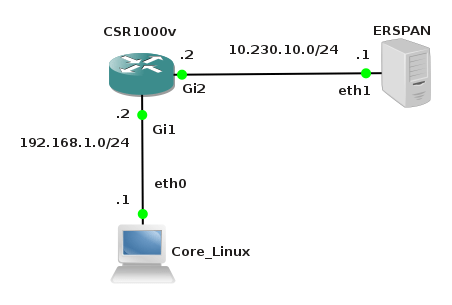Walking with Packets: Traceroute Through MPLS Cloud
Think about this for a minute: An MPLS network with a two Provider Edge (PE) routers and some Provider (P) routers. The P routers have no VRFs configured on them and therefore have no routes whatsoever for any of the customer networks. A customer then does a traceroute from one of their sites, across the MPLS cloud, and into one of their other sites. The traceroute output shows the P routers as hops along the path.
How is it possible for the P routers to reply to the traceroute if they don't have routes back to the customer network?
Decapsulation ERSPAN Traffic With Open Source Tools
Cisco Encapsulated Remote SPAN (ERSPAN) feature allows to monitor traffic on one or more ports and send the monitored traffic to one orDecapsulation ERSPAN Traffic With Open Source Tools
Cisco Encapsulated Remote SPAN (ERSPAN) feature allows to monitor traffic on one or more ports and send the monitored traffic to one or more destination ports. Traffic is encapsulated into GRE tunnel and routed via network to ERSPAN destination. Any device that supports ERSPAN can be used as ERSPAN destination. It might be another Cisco device or Linux with installed software that can decapsulate GRE traffic.
The goal of this article is to show methods and tools for decapsulation of ERSPAN traffic. For this purpose I have built simple lab that consists of a Cisco CSR 1000v router and two Linux boxes. Core Linux represents a network host and generates network traffic (ICMP) that is going to be monitored. It is connected to the port GigabitEthernet1 of the Cisco router. The router is configured to monitor traffic on the port Gi1 and it sends traffic encapsulated in GRE tunneling protocol to IP address 10.230.10.1. It is the IP address of the ERSPAN destination configured on Linux Security Union. Security Onion is a unique Linux distro for intrusion detection, network security monitoring, and log management based on Ubuntu however any other Linux distro can be used.
Picture 1 - ERSPAN Lab Topology
Below is an example of ERSPAN Continue reading
MPLS VPN
Thought I would put this on here, makes use of an MPLS backbone which allows for multiple VRF's to exist.Original blog post which covers50 000 Page views of orhanergun.net between March-May 2015
This blog received 50 000 page views between 1 of March and 1 th of May.I shared you couple more metrics from the site stats in addition to Pageviews. Since at the same time two classes I teach ( Pre-CCDE and CCDE ) in addition to my other jobs, I couldn’t update the blog since… Read More »
The post 50 000 Page views of orhanergun.net between March-May 2015 appeared first on Network Design and Architecture.
Quick tool: NetSetMan
I work as a consultant for many clients, often jumping from different networks. Management networks sometimes don’t have a DHCP server, in some networks I have a special IP address assigned to access some devices, in other networks I need…On Theory and Practice
I recently read a must-read blog post by Russ White in which he argued that you need to understand both theory and practice (see also Knowledge or Recipes and my other certification rants) and got a painful flashback of a discussion I had with a corner-cutting SE (fortunately he was an exception) almost two decades ago when I was teaching my Advanced OSPF course at Cisco.
Read more ...New on SDxCentral: Enhanced SDN & NFV Use Cases
 SDxCentral makes its catalog of SDN & NFV Use Cases available to the entire SDxCentral community. Track the most common SDN & NFV Use Cases on SDxCentral now.
SDxCentral makes its catalog of SDN & NFV Use Cases available to the entire SDxCentral community. Track the most common SDN & NFV Use Cases on SDxCentral now.
Are You an ACKer?
There are lots of differences in the way that individuals communicate and interact. One difference I often notice is whether a given individual does or does not respond. Using myself as an example, I will typically respond to a text message or email even if no question is posed. Often I will either Thank the sender or provide some unnecessary comment.
My wife on the other hand almost never responds to an information only message. If nothing is being requested, don’t expect a response. I find that lots of people exhibit this behavior and there’s nothing wrong with it. The lack of a response doesn’t necessarily mean the information isn’t appreciated. It is important to realize that just because you do something a certain way, don’t expect others to do the same.
I’d love to hear from you, so share your thoughts by commenting below.
Disclaimer: This article includes the independent thoughts, opinions, commentary or technical detail of Paul Stewart. This may or may does not reflect the position of past, present or future employers.
The post Are You an ACKer? appeared first on PacketU.
SDxCentral Weekly News Roundup — May 1, 2015
 OpenStack's 11th release, Kilo, is now available, and Nokia's CEO defends the Alcatel-Lucent deal.
OpenStack's 11th release, Kilo, is now available, and Nokia's CEO defends the Alcatel-Lucent deal.
Making the Most of Multi-User MIMO
With the first Wave 2 802.11ac access points hitting the market, Wi-Fi goes gigabit in a big way. Yet to realize such speeds means maximizing a number of new sophisticated RF capabilities that the vast majority of today’s Wi-Fi access...OpenCloud Connect Attempts Liftoff for Cloud Standards
 The former CloudEthernet Forum has started showing off its work.
The former CloudEthernet Forum has started showing off its work.
